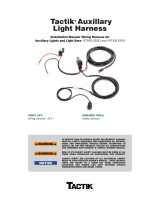
•Usingthemachinedemandsattention.Topreventloss
ofcontrol:
–Operateonlyindaylightorwhenthereisgood
articiallight.
–Driveslowlyandwatchforholesorotherhidden
hazards.
–Donotdriveclosetoasandtrap,ditch,creek,or
otherhazard.
–Reduceyourspeedwhenmakingsharpturnsand
whenturningonhillsides.
–Avoidsuddenstartsandstops.
–Beforebackingup,looktotherearandensurethat
nooneisbehindthemachine.
–Watchoutfortrafcwhennearorcrossingroads.
Alwaysyieldtheright-of-way.
•Stayawayfromthenozzleopeningwhenthemachine
isoperating.Keepallbystandersawayfromthenozzle
openinganddon’tdirectdischargetowardbystanders.
•Donotoperatethemachineundertheinuenceof
alcoholordrugs.
•Lightningcancausesevereinjuryordeath.Iflightning
isseenorthunderisheardinthearea,donotoperate
themachine;seekshelter.
•Ifthetowvehicleenginestallsorthemachineloses
headwayandcannotmakeittothetopofaslope,donot
turnthemachinearound.Alwaysbackthetowvehicle
slowlystraightdowntheslope.
•Donottakeaninjuryrisk!Whenapersonorpet
appearsunexpectedlyinorneartheoperatingarea,stop
operation.Carelessoperation,combinedwithterrain
angles,ricochets,orimproperlypositionedguardscan
leadtothrownobjectinjuries.Donotresumeoperation
untiltheareaiscleared.
•Donottouchtheengineormuferwhiletheengineis
runningorsoonafteritisstopped.Theseareascouldbe
hotenoughtocauseaburn.
RemoteControlOperation
•Readandfollowallinstructions.
•FailuretoabidebySafetyPrecautionsmayresultin
equipmentfailure,lossofauthoritytooperatethe
equipment,andpersonalinjury.
•Useandmaintainproperwiring.Followequipment
manufacturerinstructions.Improper,loose,andfrayed
wiringcancausesystemfailure,equipmentdamage,and
intermittentoperation.
•Changesormodicationsmadetoequipmentnot
expresslyapprovedbythemanufacturerwillvoidthe
warranty
•Owner/operatorsoftheequipmentmustabidebyall
applicableFederal,State,andLocallawsconcerning
installationandoperationoftheequipment.Failureto
complycouldresultinpenaltiesandcouldvoiduser
authoritytooperatetheequipment.
•Makesurethatthemachineryandsurroundingareais
clearbeforeoperating.Donotactivatetheremotecontrol
systemuntilcertainthatitissafetodoso.
•Turnofftheremotecontrolandremovepowerfromthe
baseunitbeforeattemptinganymaintenance.Thiswill
preventaccidentaloperationofthecontrolledmachinery.
•PowercanberemovedfromtheBaseUnitbydetaching
the12-pincablesfromthebaseunitconnectorP1,orby
removingthesourcepowerfromthecircuit.
•Useadampclothtokeepunitsclean.Removemud,
concrete,dirt,etc.afterusetopreventobstructingor
cloggingthebuttons,levers,wiring,andswitches.
•Donotallowliquidtoentertheremotecontrolorbase
unitenclosures.Donotusehighpressureequipmentto
cleantheremotecontrolorbaseunit.
•Disconnecttheradiobaseunitbeforeweldingonthe
machine.Failuretodisconnectthebaseunitmayresultin
destructionofordamagetothebaseunit.
•Operateandstoreunitsonlywithinthespecied
operationandstoragetemperaturesdenedinthe
Specicationsofthisdocument.
Towing
•Checkwithyourlocalcountyorstatesafetytowing
regulations,inadditiontomeetingDepartmentof
Transportation(DOT)SafetyTowingRegulations,before
towingthedebrisblower.
•Inordertoreducethepossibilityofanaccidentwhile
transportingthedebrisbloweronpublicroads,ALWAYS
makesurethetowingvehicleismechanicallysoundand
ingoodoperatingcondition.
•ALWAYSshutdownenginebeforetransporting.
•ALWAYSinspectthehitchandcouplingforwear.
NEVERtowthedebrisblowerwithdefectivehitches,
couplings,chains,etc.
•Checkthetireairpressureonbothtowingvehicleand
debrisblower.Thedebrisblowertiresshouldbeinated
to35psi(241kpa)cold.Also,checkthetiretreadwear
onthevehicleanddebrisblower.
•ALWAYSproperlyattachdebrisblower’ssafetychainsto
towingvehicle.
•ALWAYSmakesurethatthetowingvehicle'sdirectional,
backup,andbrakelightsareworkingproperly.
•Themaximumspeedforhighwaytowingis55MPH
unlesspostedotherwise.Recommendedoff-roadtowing
isnottoexceed15MPHorlessdependingontypeof
terrain.
•Avoidsuddenstopsandstarts.Thiscancauseskidding,
orjackkning.Smooth,gradualstartsandstopswill
improvetowing.
•Avoidsharpturnstopreventrolling.
•Makesuretheblowerchuteispointingupwhentowing.
•Placechockblocksunderneathwheeltopreventrolling
whileparked.
5
























